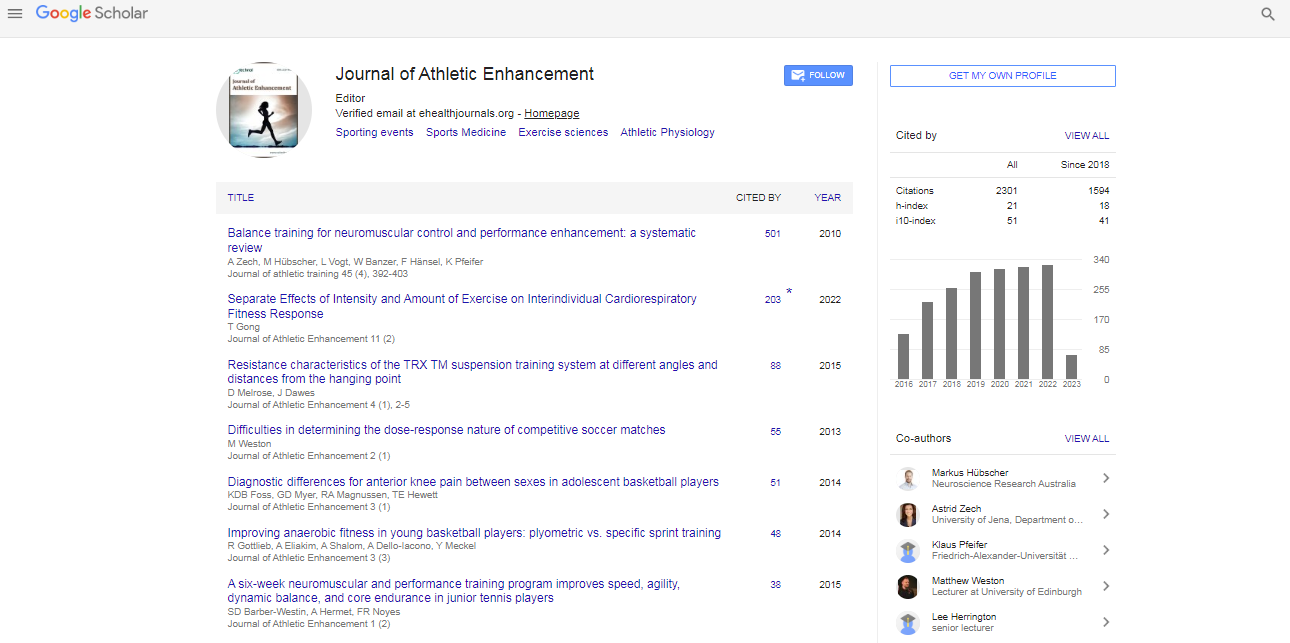Perspective, J Athl Enhanc Vol: 13 Issue: 4
Understanding Exercise Science and its Applications
Samuel Follmer*
Department of Sport Science, West Virginia University, West Virginia, United States of America
*Corresponding Author: Samuel Follmer,
Department of Sport Science, West
Virginia University, West Virginia,
United States of America;
E-mail: follmersamuel@wvu.edu
Received date: 28 June, 2024, Manuscript No. JAE-24-144914;
Editor assigned date: 01 July, 2024, PreQC No. JAE-24-144914 (PQ);
]Reviewed date: 15 July, 2024, QC No. JAE-24-144914;
Revised date: 22 July, 2024, Manuscript No. JAE-24-144914 (R);
Published date: 29 July, 2024 DOI: 10.4172/2324-9080.1000139
Citation: Follmer S (2024) Understanding Exercise Science and its Applications. J Athl Enhanc 13:4.
Description
Exercise science is an interdisciplinary field dedicated to understanding the physiological, biomechanical and psychological aspects of physical activity and its impact on health and performance. It integrates principles from various scientific domains, including biology, physiology, biomechanics and psychology, to enhance human health, fitness and athletic performance.
Core areas of exercise science
Exercise physiology: Exercise physiology focuses on how the body responds and adapts to physical activity. Exercise physiologists study the acute and chronic effects of exercise on various bodily systems, including the cardiovascular, muscular and endocrine systems. They analyse how different types of exercise such as aerobic, resistance and flexibility training affect health and performance. For instance, understanding how exercise influences cardiovascular health can help design effective interventions for preventing or managing conditions like hypertension and heart disease.
Biomechanics: Biomechanics involves the analysis of movement and the forces acting on the body. By applying principles of physics and engineering, bio-mechanists study the mechanics of human movement to improve performance and reduce injury risk. This field addresses issues such as joint mechanics, muscle function and the impact of various activities on the body. For example, biomechanical analyses can help refine athletic techniques or develop ergonomic equipment to prevent work-related injuries.
Motor control and learning: Motor control and learning examines how the brain and nervous system coordinate movement and how skills are acquired and refined through practice. Researchers in motor control study the processes underlying the initiation, execution and regulation of movement. Insights from this field are important for designing effective training programs, rehabilitation strategies and improving sports performance by optimizing motor skills.
Sport and exercise psychology: This field explores the mental and emotional aspects of physical activity. Sport and exercise psychologists study how psychological factors, such as motivation, stress and self-confidence, influence performance and adherence to exercise. They also examine how participation in physical activity affects mental health and overall well-being. Techniques from this area can be used to enhance athletic performance, improve exercise adherence and support mental health through physical activity.
Applications of exercise science
Health promotion and disease prevention: Exercise science plays an important role in promoting health and preventing disease. Regular physical activity is associated with reduced risk of chronic diseases such as obesity, diabetes and cardiovascular conditions. Exercise scientists design programs and interventions to improve public health by encouraging physical activity and educating individuals about its benefits.
Athletic performance enhancement: In sports and athletics, Exercise science is used to enhance performance through specialized training programs, injury prevention strategies and performance analysis. By applying principles from exercise physiology, biomechanics and psychology, professionals can help athletes achieve peak performance and reduce the risk of injuries.
Rehabilitation and therapy: Exercise science is integral to rehabilitation and therapy, helping individuals recover from injuries or manage chronic conditions. Exercise programs are tailored to individual needs, focusing on improving strength, flexibility and functional abilities. Physical therapists and rehabilitation specialist’s use exercise science principles to develop effective treatment plans and support recovery.
Workplace wellness: Implementing exercise programs in the workplace can improve employee health, productivity and job satisfaction. Exercise scientists design workplace wellness programs that incorporate physical activity to reduce stress, prevent musculoskeletal disorders and enhance overall well-being.
 Spanish
Spanish  Chinese
Chinese  Russian
Russian  German
German  French
French  Japanese
Japanese  Portuguese
Portuguese  Hindi
Hindi 
